Guest Post by Brady Josephson, CEO of Nonprofit Supply Co.
“If a tree falls in a forest and nobody’s around to hear it, does it make a sound?”
A famous philosophical question I’m sure you’ve heard before but I think it can be applied to online marketing & fundraising for nonprofits.
“If a nonprofit website exists and no one ever visits it, is it any good?”
You could have the most engaging website in the world but if very few people are visiting it, then it’s all for nothing. If you can’t get more visitors to your nonprofit website it won’t matter how compelling your content is, how simple it is to sign up for emails, or how easy it is to make a donation.
“You could have the best website in the world, but if few people are visiting it, it’s all for nothing.” tweet this
That’s where driving traffic – or getting more people to visit your website – comes into play. It’s key in creating awareness of your cause online which is the first stage in action focused marketing:
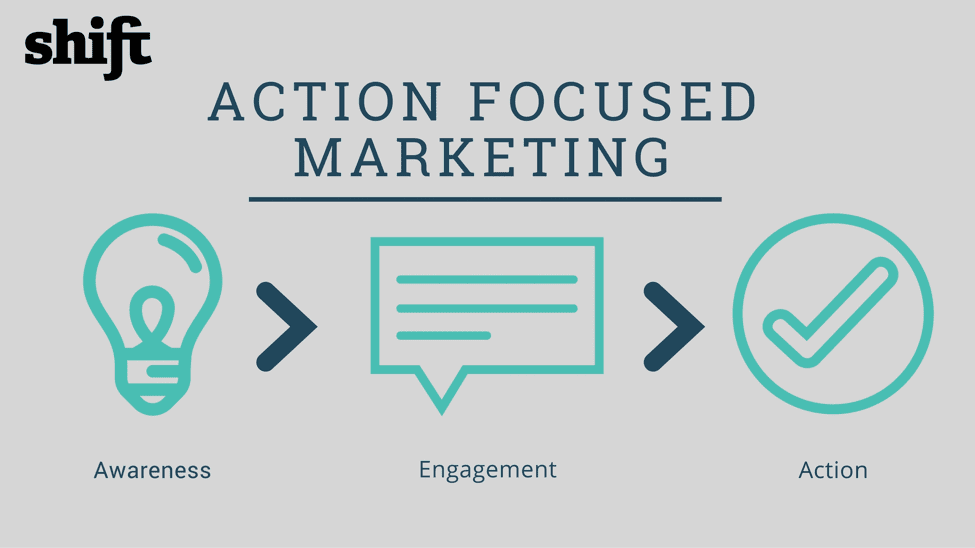
For the record, I don’t believe in ‘awareness’ campaigns. There are only action based campaigns. The action doesn’t have to be a donation – it can be sign up for email, sign a petition, or start a fundraiser – but awareness that doesn’t lead to action is (almost) completely useless.
So before we discuss how you can get more people to your website, with actions in mind, there two key concepts you need to understand:
- Goals are essential in showing the value of traffic
- Traffic is one of three variables that leads to online revenue
1. Goals And Value Of Traffic
What do you want people to do on your website? That’s the question you need to answer before you get too far into your traffic generating strategies. For most of our clients and work, it’s about getting more donors and raising more money.
But if you are a foundation, maybe you are wanting more grant applications. If you’re an advocacy organization, perhaps it’s people signing your petition. If you’re events focused, maybe it’s people buying tickets.
Whatever the action is, the key point is to choose one (and no more than three if you’re just starting out) so you can set up tracking, metrics, and goals to understand where you’re most valuable traffic is coming from.
Google Analytics is great for this and relatively easy to use so something you should be sure to set up if you don’t have it. Within Google Analytics, you can create literal goals that are triggered by destination, duration, pagers per session, or event. Destination is the simplest to implement and requires a ‘confirmation page’ after a key action is taken.
For example, having a ‘/email-signup/thank-you’ page, like this one (pictured below), where people are pointed to after signing up for your email list is a destination page.
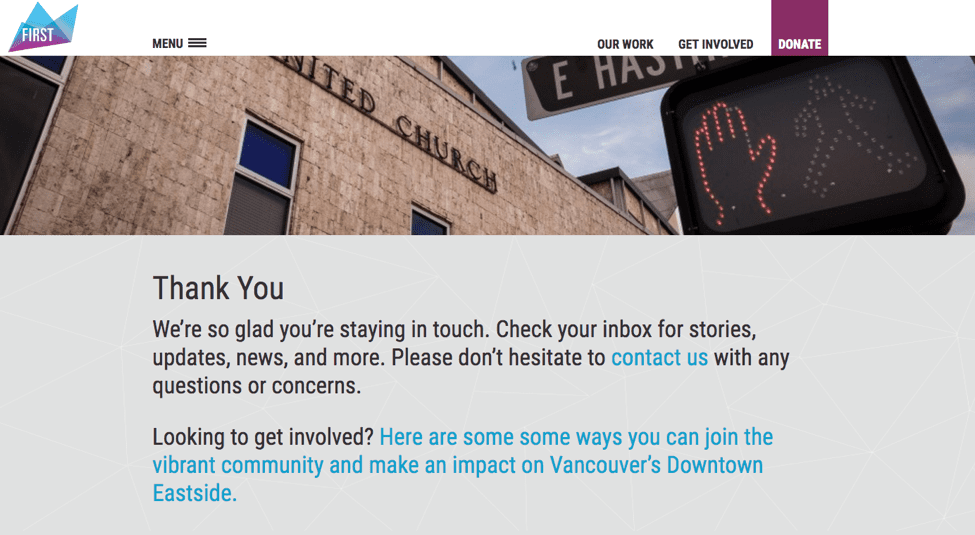
When set up as a Goal in analytics (here’s a little ‘how to’), you can then see how many people completed that action and where they came from (assuming it’s all set up right and the actions are taking place on your site).
It will look something like this:
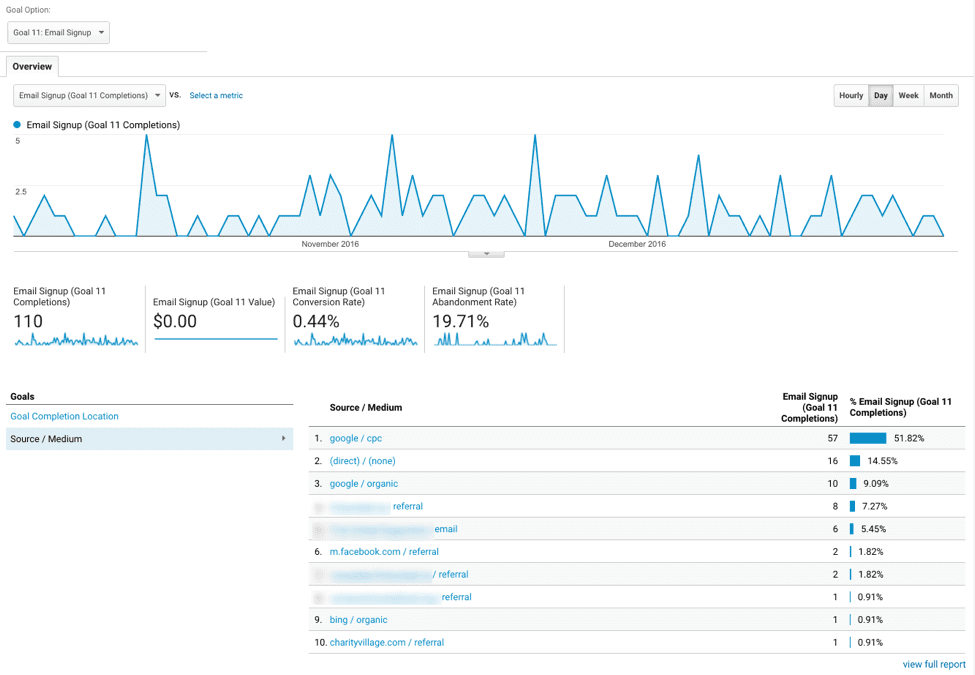
From this, you can see how many people are signing up for emails and where they are coming from. This is important as again the point is to drive action with traffic, not just get traffic for traffic sake, so now you can start to value the traffic based on actions and not just visits.
In the above example, over 50% of their email signups are coming from their Google AdWords strategy. You can also see more of the value of referral traffic and compare social media channels.
Here are some common actions/goals:
- Donations
- Email Sign Ups
- Volunteer Sign Ups
- Event Registration
- Ticket Purchase
- Content Download
- Application Submission
2. Traffic And Online Fundraising
Alright, so with goals in place you can start to see the value of traffic to your website. For most organizations we work with, the goal is to raise more funds and reach more donors so our goals focus on fundraising.
When it comes to online fundraising, traffic is one of three magic variables that are equally weighted and when multiplied together equal online revenue:
Traffic x Average Gift x Conversion = Online Revenue

The brilliant folks at NextAfter created this theoretical example of how the three metrics are related:
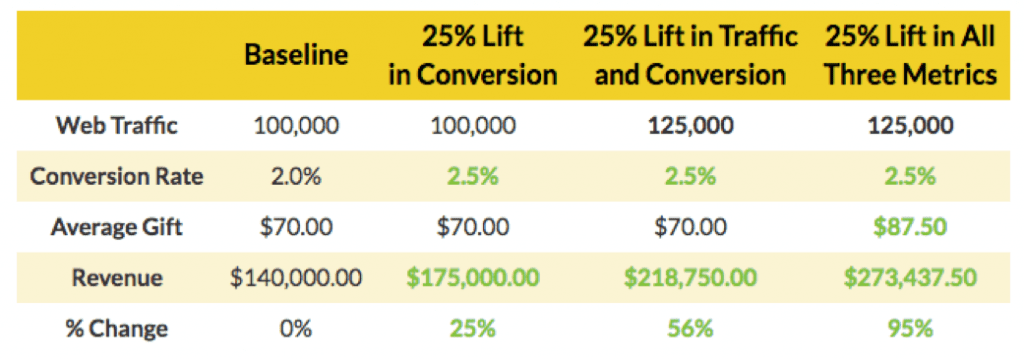
In theory, just by getting more traffic you will raise more money. Here’s an example of the link of traffic to donations from a client of ours:
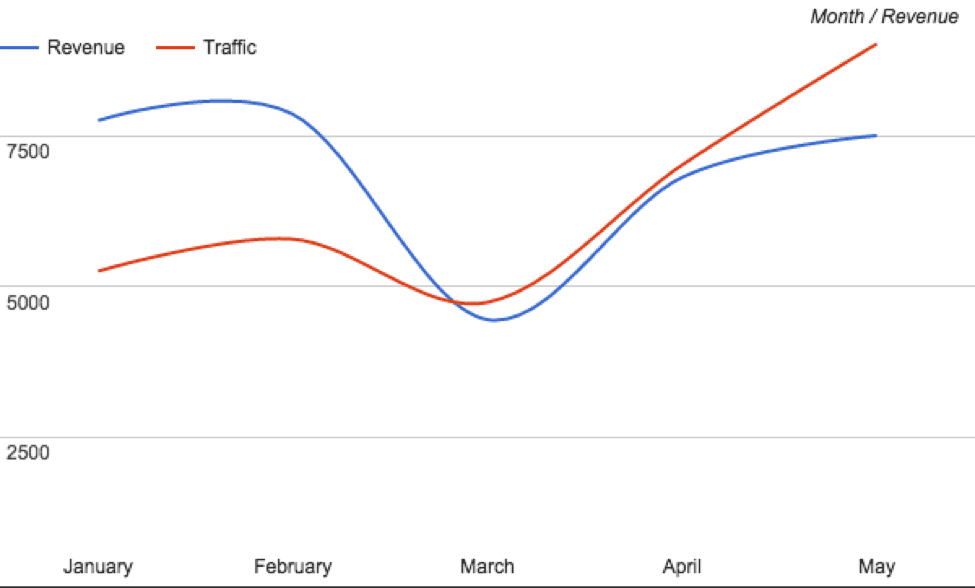
While not 100% correlated, you can see how revenue increases when traffic does. As such, getting more traffic is one of the core strategies we take with our clients to boost their online revenue.
And while we will focus on how you can just get more traffic to meet your goals and raise more funds, it is important to note that you still need a great value proposition or inspire donors to make a donation (average gift) and make it simple, intuitive, and easy for them to take that action or make a donation (conversion rate) to make the most of the traffic to your site.
Lastly, when getting new visitors to your website, that chances of first time visitors who have never heard of you going all the way to making a donation and giving you money is small.
This is why focusing on email sign ups or some action that is a bit easier for visitors to take but connects them to your organization can be very useful. This can lead to more revenue over time even though it may not show up directly because of this visit.
For what it’s worth, an email’s value can vary greatly but is roughly ‘worth’ $10 – $15 which means you should spend $2 – $3 to acquire emails via paid strategies – more on those below.
4 Ways To Get More People To Your Nonprofit Website
Empower It
While getting people to your site is a goal, one of the best strategies to do that is people themselves. Social media is the great equalizer when it comes to marketing as a great story, campaign, or video can spread through networks increasing awareness as they go and, hopefully, getting some people back to your site.
Make sure you include links back to your website in your social posts, profiles, and videos so people are just a click or memorable URL away from getting more content on your site and taking those actions you are wanting.
People often have larger, more connected social followings than organizations do themselves which means a tweet or post from them can get more views, clicks, and shares that from the organization page. And that’s often just ONE person.
When you add up the social capital for ALL the people following you the collective reach and power is quite astounding. And people with social capital often like to use it. Particularly for ‘good’.
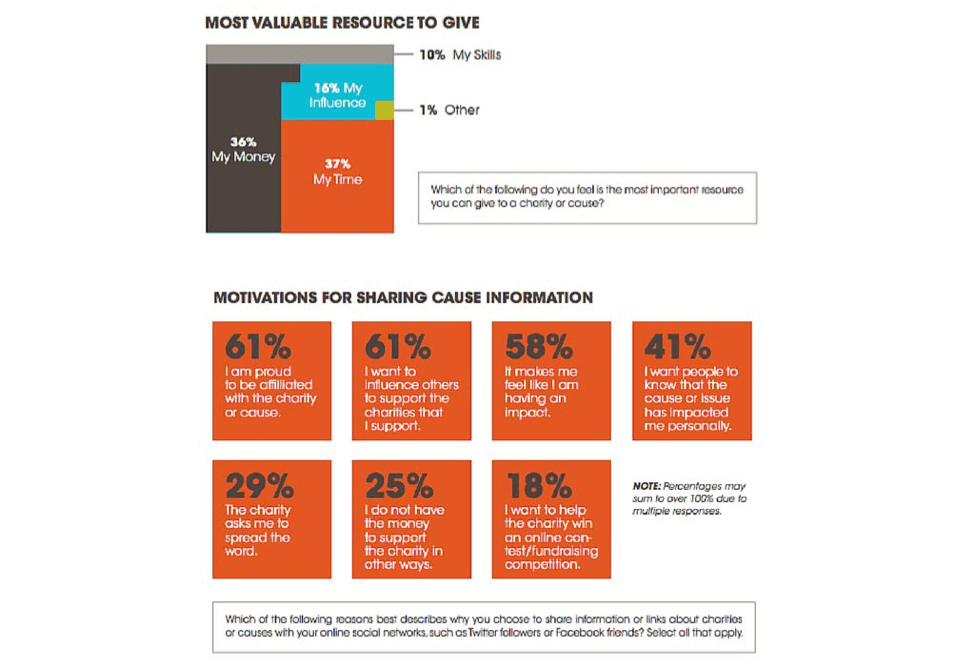
So ask them.
On a key post, ask people to share it. If you really want to get into it, you can try and identify your followers and email subscribers who have social capital or are really engaged with you and message/email them specifically to ask them to share on your behalf. That’s an influencer strategy.
Most of the time when people talk about influencers you think of celebrities – Bieber, Beckham, Brady (Tom… Not me…). But regular folks have a lot of sway with their networks and that’s really who are more likely to give and support you anyways. People like your current supporters.
An influencer strategy is best done when you make your influencers feel special, unique, and exclusive. Give them content before anyone else. Treat them with little perks like discounted event tickets, updates just for them, or a call with leadership no one else can get.
Just a final note on social traffic, in our analysis with clients, we’ve seen social media – particularly Facebook – be a great source of traffic but it isn’t always a high value source in terms of actions and engagement – particularly on mobile.
That doesn’t mean it’s not useful, but social media traffic is perhaps a bit more on the ‘awareness’ side of things and not as close to action as say email subscribers are. So a great strategy is to use social sharing and social media to get more and new people to your site to sign up for emails. From there, they can make donations, sign petitions, or be a social sharing superstar themselves.
Earn It
This is one of the hardest, longest strategies but probably the most valuable over time. When you’ve earned the attention, you have been doing great work, creating great content on your site and sharing on social and people are engaging and sharing. These are all factors which improve your Search Engine Optimization or SEO. It means people looking for you or content related to you are more likely to find you.
Organic search is often one of the largest traffic sources – if not the largest source – of traffic to your site. Here’s an example of organic search (and paid) traffic from a few of our clients for example:

Having high organic search traffic can show that your work is connecting with people and can often be a source of new donors and supporters. Make sure you have a good and easy way to sign up for emails to allow people to take an action (there’s that word again…) but then you can pull people back to your site and content with regular emails.
“Having high organic search traffic can show that your work is connecting with people.” tweet this
Building up your organic search performance is quite complex but some things that help are:
- Having an SEO friendly, mobile optimized, and well structured website
- Producing great and digestible content (blogs, videos, annual reports, etc.)
- Having a good PR strategy (where you are in the news leading people to search for you)
- Empowering people to share content (which has an ever greater role in Google’s SEO ranking algorithms)
Buy It
Earning it and empowering it strategies are ‘free’ – in brackets because they still take a lot of time and effort – but you can simply buy visitors with Pay Per Click (or PPC) online advertising. These strategies can be done primarily through search (like Google AdWords), display (banner ads), and social (Facebook, Twitter, LinkedIn).
While organic search and social sharing are great you don’t have full control on who sees it, when, and if the viewers are right for you and your organization. A PPC strategy gives you that control but you have to pay on a per click basis through a bidding system.
Using Google AdWords as a paid search marketing example, let’s say your cause works in clean water projects in Ethiopia. If someone searches ‘clean water crisis in Africa’ after seeing something on the news perhaps, they are most likely high quality traffic. They are showing interest in something close to what you do and are actively looking for content.
In AdWords, you can bid on keywords, words or phrases you want to ‘own’, like ‘clean water Africa’. You submit what you are willing to pay to show up on that keyword and if you bid high enough (bid) and your ad and landing page you are pointing them to is relevant enough (quality score) your ad will show up higher on the page and get more clicks (more on how AdWords and the ‘auction’ works here).
If they click, you get charged. Since you have set up your key actions – like email sign ups – and tracking – with goals – you’ll actually be able to see if these visitors take actions and how much it cost you for certain actions. In advertising, this is called a conversion.
If you spend $100 to get 50 clicks or people to your site, your Cost Per Click (CPC) is $2. If 10 of those 50 people sign up for email, you got 10 conversions out of 50 people (20% conversion rate) and a cost of $100 for a Cost Per Conversion of $10.
Remember that a rough benchmark for email value is $15 so, in theory, if you can secure a new email for anything less than $15 you will make a profit over time.
You can use a PPC strategy on different devices (desktop, mobile) and channels (Google Display, social, etc.) so we recommend picking a channel or two to start experimenting with. Taking a look at your current traffic sources in terms of volume and quality is a great place to start.
For our clients, we focus on Google AdWords with a free Google Ad Grant (more below) and for paid ads we focus on Facebook where we’ve seen more results and success to date. One of the most cost effective paid advertising strategies we’ve seen is retargeting or remarketing.
This is a tactic that allows you to show ads only to people who have visited your website or are on your email list. This is beneficial as you are now only showing ads to people who have shown interest in not just your cause but YOU at some point making them more likely, in theory, to make a donation or take a desired action.
You can get more detailed as well and only show ads, for an Ethiopian water project for example, to people who have visited your page talking about Ethiopian water projects. This should make your ad more relevant to them and decrease your cost of donor acquisition.
A paid strategy can be hugely beneficial as the levels of targeting and control are much greater. For this strategy to work however, it’s imperative you have proper tracking set up (like eCommerce for online donations) and Goals so you can see the ROI (or not) and make adjustments. If you can’t track the actions, a paid strategy can be dangerous and a waste of time and resources.
Buy It (For Free)
Last but not least, there are ways to participate in a paid strategy to grow your traffic without paying for it. Sounds too good to be true right? Well it kind of is (more on that later) but programs like Google’s Ad Grant program allow qualified organizations to get up to $10,000 in free search advertising to use. Each month.
Not ALL nonprofits qualify (most do) and there are some limitations on the account like a per day max, a per click max, and number of domains or URL’s you can point ads to (this post covers the program well with additional info).
The great thing about the Google Ad Grant program, is that it allows you to ‘compete’ in the search world with a paid strategy but at no cost. For example, here’s an example of a search ‘volunteer in Vancouver’ for one of our clients who want to get more local volunteers:

And here’s what that search would look like without the Ad Grant strategy:

I’ve highlighted the page number, as they didn’t show up on the first 10 pages of Google search results without the ad! That client, probably like you, can’t afford to pay $2 – $5 per click to recruit a volunteer so your left with your search ranking alone. But with the Google Ad Grant, you can at least compete, show up higher, get more clicks, and recruit more support.
And while the best use of the ad grant is on less competitive keywords and focused on actions like volunteering or accessing great content, it can be a source of donations. Here’s a donation summary from a client for the last quarter of 2016 (viewed in Google Analytics with eCommerce set up):
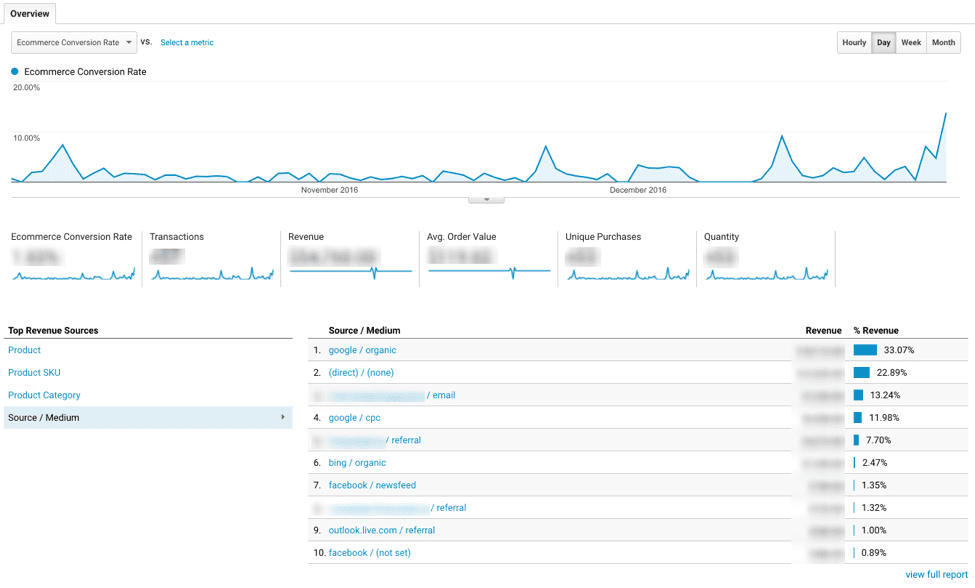
You can see that AdWords accounted for 12% of ALL online donations in that time period. We’ve seen results like this – when it comes to acquiring emails, increasing traffic, and growing donations – time and time again with our clients so we actually started Nonprofit Supply Co. to help get and manage AdWords for nonprofits across North America. Whether you use us, someone else, or do it yourself, we strongly recommend the Google Ad Grant be a key part of your traffic generation strategies.
Getting traffic is not the end goal – driving action is. But getting more people to your website can be hugely valuable in driving action especially if you have goals/tracking set up and a good user experience for people taking those actions. You can then see which traffic sources and strategies are most valuable to you and your cause helping you invest your time, money, and energy accordingly.
“Getting traffic is not the end goal – driving action is.” tweet this

Brady is a charity nerd, entrepreneur, digital marketer, professor, and writer. He’s the founder and Chief Strategist at Shift, a digital first marketing agency for charities, CEO at Nonprofit Supply Co., equipping small and medium sized nonprofits with ideas, services, and tools they need in the digital age. He’s also the creator and host of The Good Journey Pod, a weekly podcast with thought leaders, philanthropists, and innovators shaping the world of ‘good’. You can read his writing at recharity.ca and follow him on Twitter @bradyjosephson.
Editor's Picks
Ultimate Guide To Peer-to-Peer Fundraising
Customer Story: Spur Local Raises Over $1M With Their Give Local Campaign
Fundraising Strategies for Nonprofits: Craft the Best Approach for Your Organization
Create a Killer Fundraising Plan - Best Practices, Strategies, & Downloadable Template




